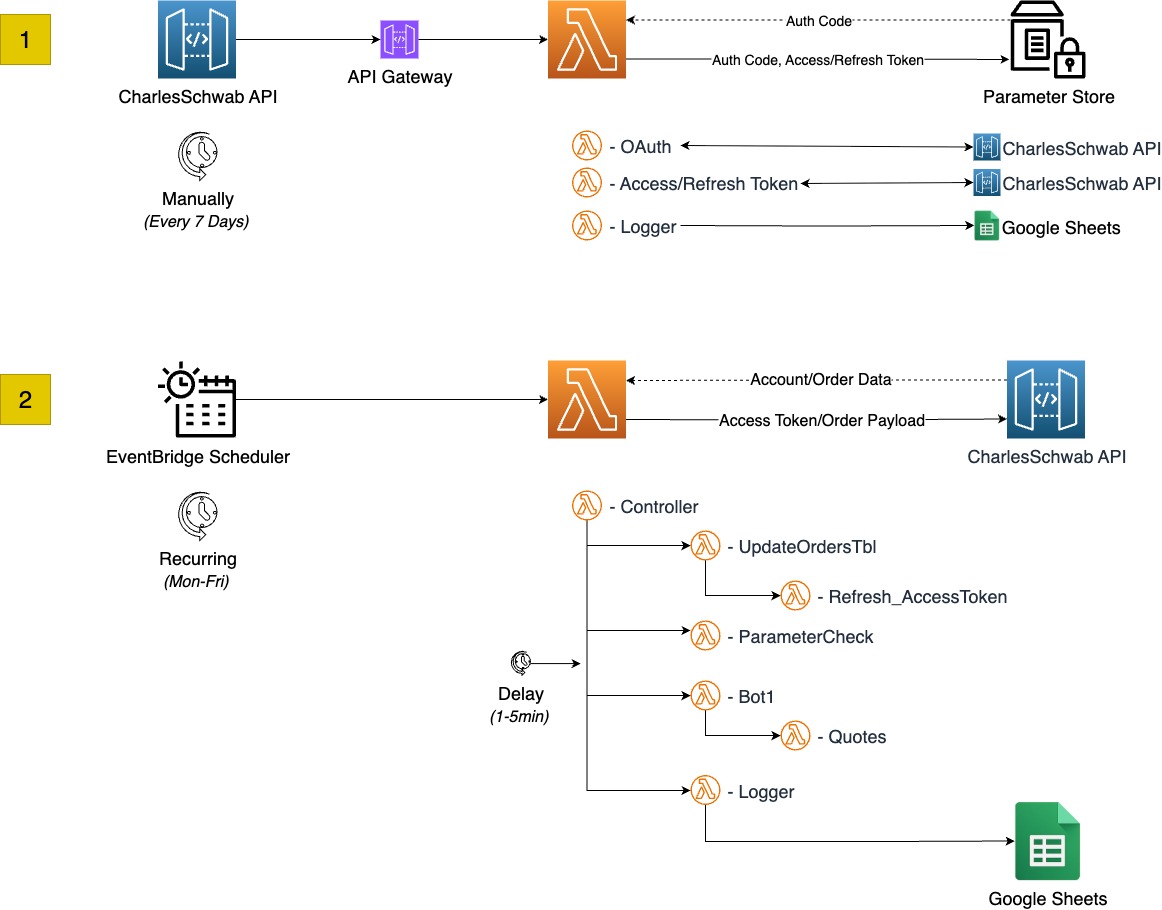Serverless Trading Automation System
AWS-Powered Architecture
By Anthony Govoni
Overview
This project is a modular, event-driven trading automation system built entirely on AWS serverless infrastructure. The system ingests real-time data, evaluates strategy conditions, and places trades in a scalable, secure, and cost-efficient environment. It is designed to execute trades based on dynamic market conditions without the need for persistent servers or manual oversight.
System Architecture & Detailed Build
1. Lambda-Driven Orchestration
The system is composed of multiple independently deployable AWS Lambda functions, each designed with single-responsibility principles. These functions communicate via JSON payloads, enabling clean modularization and stateless execution. Core Lambda workflows include:
- Market holiday & open checks
- Strategy evaluation based on price drops from 52-week highs
- Purchase limit tracking
- Trade execution via brokerage API
2. Configuration & Security via AWS Parameter Store
Sensitive data and configuration variables—such as API keys, thresholds, and quantity tiers—are stored securely in AWS SSM Parameter Store. This allows for:
- Secure access controls
- Easy updates across dev/stage/prod environments
- Cleaner Lambda code via dynamic config injection
3. Trade History & Compliance with DynamoDB
A central DynamoDB table stores historical trade data, including:
- Ticker symbols
- Purchase timestamps
- Monthly orders
A Global Secondary Index (GSI) enables real-time filtering and enforcement of trade constraints like "max 4 shares per month per stock."
4. Shared Logic with Lambda Layers
To avoid code duplication, a custom Lambda Layer includes:
- Pandas for data manipulation
- Utility functions (e.g., percent-from-high calculations, date parsing)
- Consistent environment for all trading logic functions
5. Observability with Google Sheets
All trade decisions and system events are logged to Google Sheets using a webhook-style endpoint. This provides:
- Real-time observability
- Easy stakeholder access
- Auditable logs for all trade activity
6. Real-Time Market Data via External APIs
Market data is pulled on-demand via secure API calls within Lambda functions. These requests are stateless and triggered only during active trading windows, optimizing costs and performance.

Goals
- Fully automate trading decisions using programmable logic and real-time data.
- Design a scalable, serverless system that minimizes operational overhead.
- Track and limit monthly trades to remain within compliance boundaries.
- Log all trade-related actions in a human-readable format.
- Ensure secure handling of configuration data and credentials.
Findings
- Loose coupling between components made it easy to isolate/fix issues in individual Lambda functions without impacting others.
- Serverless architecture significantly reduces idle costs, as functions only incur charges during execution.
- Google Sheets as a logging tool was surprisingly effective for quick insights and debugging.
- DynamoDB GSIs proved critical in efficiently querying time-bound purchase data.
Insights & Lessons Learned
- Real-time API dependencies must be handled defensively, with retry logic and clear error propagation between functions.
- AWS Parameter Store is an ideal solution for managing credentials securely, especially in multi-environment pipelines.
- A well-structured JSON payload contract between Lambda functions is crucial for maintainability and debugging.
- Building reusable logic into Lambda Layers drastically reduces redundancy and simplifies updates.
Next Steps / Enhancements
- Enhance strategy logic to incorporate moving averages, RSI, or other technical indicators.
- Implement backtesting functionality using historical data to refine strategy thresholds.
- Expand multi-stock support and portfolio-level risk management logic.
- Add more robust error alerting via AWS SNS or Slack integrations.